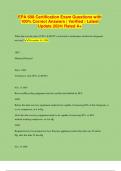Exam (elaborations)
TEST BANK For Anatomy & Physiology 10th Edition by Kevin T. Patton , ISBN: 9780323529044 ||Complete Guide A+
Anatomy and Physiology 10th Edition Patton Test Bank Instant delivery. Chapter 01: Organization of the Body Patton: Anatomy and Physiology, 10th Edition MULTIPLE CHOICE 1. Which of the following describes anatomy? a. Using devices to investigate parameters such as heart rate and blood pressure b. I...
[Show more]












